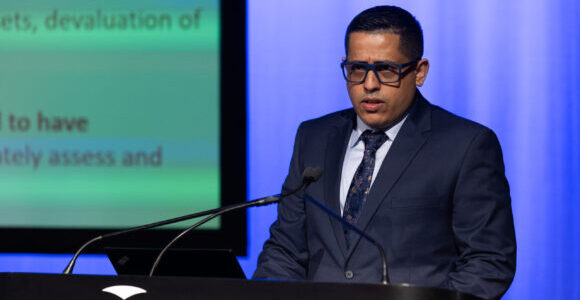The Bank of Papua New Guinea’s Green Finance Centre was established in 2024 to encourage financial institutions to fund sustainability-related projects. The centre’s head Mohinesh Prasad shares the progress being made on green finance with Business Advantage PNG – and its potential to boost PNG’s economy.

Green Finance Centre’s Mohinesh Prasad. Credit: BAI/Stefan Daniljchenko
BAPNG: How are things progressing with implementation of the Green Taxonomy?
Mohinesh Prasad (MP): The Green Taxonomy was launched by the Prime Minister and the Governor of the Bank of PNG [BPNG], Elizabeth Genia, in June 2023 and covers 11 sectors. We can’t work on all the sectors at the same time, so our technical working group voted to prioritise five: renewable energy; energy efficiency; agriculture, sustainable land use and marine resources; water and wastewater; and clean transport.
We’re developing technical screening criteria with the help of the IFC [International Finance Corporation] for each sector, starting with renewable energy and energy efficiency. These are the low-hanging fruit. For example, we’re seeing strong demand from companies wanting to install rooftop solar and reduce fossil fuel use.
We’re aiming to complete draft criteria for these two by August, and clean transport by December.
“To tap into the potential [for green finance], we need to get our governance right.”
BAPNG: Have there been any pilot programs or actual lending aligned with the taxonomy?
MP: As a pilot, we decided to work with three commercial banks and two microfinance banks, together covering over 80 per cent of the finance sector: BSP, Kina Bank, ANZ, MiBank and MamaBank.
We conducted a needs assessment of all five banks in their sustainable lending portfolios. Based on this assessment, we’re working with them to identify opportunities to develop new green products and integrate the Green Taxonomy on their lending operations.
We’ve already run pilot lending through the microfinance banks with approximately K10 million in loans to test the concept, and it’s working well. This was focused on agriculture, mainly coffee and cocoa, given the high commodity prices.
Across the five partner banks and a few private sector players, we’ve identified over K270 million worth of preliminary green investments that could proceed, subject to responsible lending, and once we have sufficient contribution in the facilities. All this lending will be aligned to the Green Taxonomy, which becomes the core for green lending in Papua New Guinea.
BAPNG: What are the facilities being planned to support green lending?
MP: At the Green Finance Summit [in Port Moresby] in March, the Governor of the BPNG introduced two new financial instruments: the Green Refinancing Facility and the Green Guarantee Facility.
The refinancing facility aims to contribute liquidity to encourage banks to lend to green projects. This support will help reduce the cost of capital and allow them to lower interest rates.
But for some banks, liquidity isn’t enough – they need help managing risk. That’s where the guarantee facility comes in: It shares lending risk in priority sectors like agriculture, which involves 85 per cent of the population but remains risky.
The French Development Agency, AFD, has committed US$2 million to the refinancing facility, and we’re working on additional seed capital for the guarantee facility. Another international partner has agreed in principle to inject US$20 million, subject to due diligence.
The guarantee facility was supposed to come later in 2026, but under Governor Genia’s leadership and through the support of AFD and GGGI [Global Green Growth Institute] we have managed to bring it forward this year to complement the refinancing facility.
BAPNG: What other projects are you focusing on this year?
MP: We’re developing two key frameworks this year: ESG guidelines, which we hope to finalise in the coming months, to help banks align with international ESG standards.
The other is a thematic bond framework, which we’re working on with the Securities Commission, PNGX [PNG’s stock exchange] and the IFC.
We’ve identified a few pilot private sector organisations that could possibly issue green or sustainable bonds in the near future. We are putting a project together to support them build policies and frameworks, which we hope to have ready by early next year – these frameworks will provide proper governance to be able to attract credible investors.
BAPNG: How big is the overall potential for green finance in PNG?
MP: At the Green Finance Summit, during the Climate Finance Roundtable co-chaired by IMF and Governor Genia, we agreed on six workstreams aimed at mobilising climate finance. These may have the potential to mobilise US$1 billion in green financing in the next two years.
But to tap into this possibility, we need to get our governance and domestic stakeholder coordination right. We need proper systems. We need to demonstrate things are working. And I think that’s where the BPNG is taking strong leadership.
Mohinesh Prasad will be speaking at the 2025 PNG Investment Conference, held on Monday 11 & Tuesday 12 August at the Brisbane Convention and Exhibition Centre. You can register to attend the event and find out more information about it, here.









Speak Your Mind